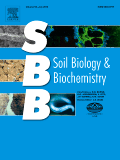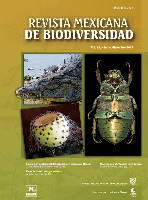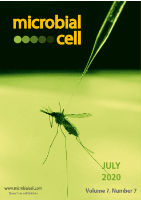
MICROBIAL ECOLOGY
Scope & Guideline
Unveiling the secrets of microbial ecosystems.
Introduction
Aims and Scopes
- Microbial Diversity and Community Structure:
The journal explores the diversity of microbial communities across different environments, including marine, freshwater, and terrestrial ecosystems, with a focus on taxonomic and functional diversity. - Microbial Interactions and Ecosystem Functioning:
Research published in this journal investigates the interactions among microbial populations, including competition, predation, and symbiosis, and how these interactions influence ecosystem processes and health. - Environmental Influences on Microbial Dynamics:
The journal addresses how various environmental factors such as temperature, salinity, and nutrient availability affect microbial community composition, dynamics, and metabolic functions. - Application of Molecular Techniques:
Utilizing advanced molecular methods, such as metagenomics and flow cytometry, the journal emphasizes the importance of these techniques in understanding microbial ecology and community interactions. - Impact of Global Change on Microbial Ecology:
The journal focuses on the effects of climate change, pollution, and other anthropogenic factors on microbial communities, emphasizing the implications for ecosystem resilience and functionality.
Trending and Emerging
- Microbial Responses to Climate Change:
Research exploring how climate change impacts microbial communities and their functions is gaining traction, emphasizing the role of microbes in ecosystem resilience and biogeochemical cycles. - Microbial-Eukaryotic Interactions:
There is an increasing focus on the interactions between microbes and eukaryotic organisms, particularly in aquatic systems, shedding light on symbiotic relationships and their ecological significance. - Molecular Ecology and Metagenomics:
The application of molecular techniques, including metagenomics and advanced sequencing methods, is on the rise, enabling comprehensive insights into microbial diversity and community dynamics. - Microbial Role in Ecosystem Services:
Emerging studies highlight the role of microbes in providing ecosystem services, such as nutrient cycling and pollutant degradation, underscoring their importance in environmental management. - Impact of Anthropogenic Activities on Microbial Communities:
Research focusing on how human activities, including pollution and habitat alteration, affect microbial community structure and function is increasingly prevalent, reflecting a growing concern for ecosystem health.
Declining or Waning
- Traditional Laboratory-Based Microbial Studies:
There has been a noticeable decline in studies that rely solely on traditional laboratory methods for microbial analysis, as the field shifts towards more in situ and ecological approaches that consider environmental context. - Focus on Single Species Studies:
Research concentrating on single microbial species has decreased in favor of studies examining community-level dynamics and interactions, reflecting a broader understanding of ecological networks. - Static Models of Microbial Interactions:
The use of static models to describe microbial interactions is waning, as researchers increasingly adopt dynamic and systems-based models that account for temporal changes and environmental variability. - Limited Geographic Scope:
Papers focusing exclusively on localized studies without broader ecological implications or comparisons to global patterns are diminishing, as the journal encourages more integrative and comparative research.
Similar Journals

Soil Ecology Letters
Championing Groundbreaking Discoveries in Soil ScienceSoil Ecology Letters, published by SpringerNature, is a premier journal dedicated to advancing the knowledge and understanding of soil ecosystems, their functions, and their vital role in global sustainability. Since its inception in 2019, this leading journal has consistently maintained its prestigious Q1 ranking in Ecology, Evolution, Behavior and Systematics, as well as Soil Science, reflecting its significant impact in the ecological and environmental sciences community. With an impressive Scopus ranking that places it within the top percentile of journals in its field, Soil Ecology Letters provides a platform for researchers and professionals to disseminate their groundbreaking findings. The journal is a vital resource for advancing research in agricultural and biological sciences, offering open access options that promote widespread dissemination of knowledge. With its focus on fostering collaboration and innovation in soil ecology, this journal is essential reading for anyone aiming to deepen their understanding of soil environments and their critical role in ecological health.

npj Biofilms and Microbiomes
Connecting Researchers to the Frontiers of Microbial Sciencenpj Biofilms and Microbiomes, published by Nature Portfolio, is a premier open-access journal that has been at the forefront of research since its inception in 2015. With an impressive impact as reflected by its 2023 category quartiles, ranking in the Q1 tier for Applied Microbiology and Biotechnology, Biotechnology, and Microbiology, this journal plays a pivotal role in disseminating high-quality research focused on the intricate relationships between biofilms and microbial communities. Situated in the United Kingdom and backed by the esteemed Nature Publishing Group, it readily appeals to the academic community, providing a platform for innovative and interdisciplinary studies. By fostering accessibility, it enables researchers, professionals, and students to explore the latest advancements in microbiome research and its application across various sectors. The journal's commendable Scopus rankings further underscore its significance within the scientific dialogue, ranking in the top percentile across the disciplines of microbiology. As it continues to evolve with a converged publishing model through 2024, npj Biofilms and Microbiomes remains a vital resource for those engaged in the quest to understand and harness the potential of microbial ecosystems.

Fungal Ecology
Connecting Research and Innovation in Fungal BiologyFungal Ecology, published by Elsevier Science Ltd, is a leading international journal dedicated to the exploration and advancement of our understanding of fungal biology and its ecological significance. With an impressive impact factor and recognized in the second quartile (Q2) across various categories such as Ecological Modeling, Ecology, Ecology, Evolution, Behavior and Systematics, and Plant Science, this journal offers a critical platform for researchers and professionals to disseminate and discuss innovations in fungal ecology. Since its inception in 2008, the journal has built a solid reputation, particularly highlighted by its impressive Scopus rankings, including a top percentile status in ecological fields. Researchers are encouraged to submit their findings that contribute to the understanding of the ecological roles of fungi, their interactions within ecosystems, and their applications in environmental science. Although the journal does not offer open access, it remains a vital resource for academics and practitioners aiming to stay ahead in the rapidly evolving fields of fungal research and ecology. Located in the vibrant heart of the Netherlands, the journal continues to foster scholarly engagement and collaboration among scientists globally.

mSphere
Connecting researchers to the forefront of microbiological discovery.mSphere is a leading open-access journal published by the American Society for Microbiology, dedicated to the dynamic fields of Microbiology and Molecular Biology. Since its inception in 2016, mSphere has rapidly established itself as a reputable source of scholarly research, achieving notable impact factors and excellence within the academic community. The journal ranks in the top quartile (Q1) amongst its peers in Microbiology, and Q2 in the field of Molecular Biology, demonstrating its significance and relevance through Scopus rankings—specifically, it holds the #42 spot out of 182 in the Microbiology category and #108 out of 410 in Molecular Biology. With an editorial commitment to advancing the understanding of microbial and molecular sciences, mSphere provides an accessible platform for researchers, professionals, and students alike to disseminate groundbreaking findings. The journal promotes rigorous peer-review and invites innovative contributions aimed at enhancing microbial research mobility and molecular exploration. Accessible openly since 2016, mSphere continues to thrive as an influential publication driving scientific dialogue and discovery in the microbiological sciences.

WORLD JOURNAL OF MICROBIOLOGY & BIOTECHNOLOGY
Exploring Breakthroughs in Microbial and Biotechnological ResearchWORLD JOURNAL OF MICROBIOLOGY & BIOTECHNOLOGY, published by Springer, serves as a pivotal forum for advancing the fields of microbiology and biotechnology since its inception in 1990. Located in the Netherlands, this esteemed journal has secured a prominent position in the academic landscape, recognized for its strong impact factor and prestigious Q2 category rankings across disciplines such as Applied Microbiology, Biotechnology, and Physiological Sciences. Researchers and professionals utilize this journal to disseminate innovative findings and explore emerging technologies that are transforming the scientific landscape. With a robust submission rate and high visibility among the academic community, the journal fosters interdisciplinary collaboration, encouraging discussions that bridge gaps between theory and practical applications. As it converges into 2024, the WORLD JOURNAL OF MICROBIOLOGY & BIOTECHNOLOGY continues to be a vital resource for scholars aiming to enhance our understanding of microbial processes and biotechnological advances.

SOIL BIOLOGY & BIOCHEMISTRY
Innovating Insights into Soil BiochemistrySOIL BIOLOGY & BIOCHEMISTRY, published by Pergamon-Elsevier Science Ltd, is a premier academic journal that plays a pivotal role in advancing the fields of microbiology and soil science. Established in 1969, this esteemed journal has gained recognition for its rigorous publication standards and impactful research contributions, evidenced by its prestigious Q1 rankings in both Microbiology and Soil Science categories for 2023. With an impressive Scopus rank of #3 among 159 in Agricultural and Biological Sciences and #14 among 182 in Immunology and Microbiology, it boasts a notable 98th percentile in its field. The journal offers researchers, professionals, and students a vital platform for sharing innovative studies and insights about soil ecosystems and their biochemical processes, fostering greater understanding and collaboration within the scientific community. While Open Access options are currently not available, the journal remains a cornerstone for those seeking to deepen their knowledge and contribute significantly to soil biology and biochemistry.

Revista Mexicana de Biodiversidad
Connecting Science and Conservation for a Thriving PlanetRevista Mexicana de Biodiversidad is a prominent academic journal dedicated to the field of biodiversity and conservation, published by the prestigious Instituto de Biología, Universidad Nacional Autónoma de México. Since its inception as an Open Access publication in 2005, it has aimed to disseminate high-quality research that advances the understanding of biological diversity in Mexico and beyond. With an ISSN of 1870-3453 and an E-ISSN of 2007-8706, the journal caters to a diverse audience, including researchers, professionals, and students, by providing vital insights into ecological studies, conservation strategies, and the sustainable management of natural resources. The journal is committed to fostering scientific collaboration and promoting the significance of biodiversity in addressing contemporary environmental challenges. By publishing innovative and impactful research, the Revista Mexicana de Biodiversidad plays an essential role in the global discourse on biodiversity conservation.

ISME Communications
Empowering Researchers to Shape a Greener TomorrowISME Communications is an esteemed journal dedicated to advancing the field of environmental microbiology and its multifaceted intersections with ecology, biogeochemistry, and biotechnology. Published by SpringerNature, this journal aims to disseminate cutting-edge research and innovative insights that address pressing global challenges through interdisciplinary approaches. With a commitment to open access, it provides a platform for researchers, professionals, and students to share their findings widely, fostering collaboration and knowledge exchange. Although the journal is relatively new, its potential for impactful contributions is substantial, making it an essential resource for anyone interested in the microbial processes that underpin ecosystem functioning and sustainability. The journal not only prioritizes the rigorous peer-review process but also supports the academic community's pursuit of excellence in environmental science.

Biogeosciences
Exploring the intersections of life and earth sciences.Biogeosciences, published by COPERNICUS GESELLSCHAFT MBH in Germany, is a prestigious open access journal that has been a leading platform for innovative research since its establishment in 2004. With an impressive impact reflected in its Q1 rankings within both the Earth-Surface Processes and Ecology, Evolution, Behavior and Systematics categories, it caters to a diverse readership encompassing researchers, professionals, and students engaged in the life sciences and earth sciences. The journal's commitment to disseminating high-quality research is evident from its exemplary Scopus rankings, highlighting its role in fostering advancements and discussions in biogeoscience. With full open access options, readers worldwide can freely explore significant findings that contribute to our understanding of ecological and geoscientific principles. As the journal converges into its next decade, it continues to be an essential resource for those seeking to bridge the disciplines of biology and earth sciences.

Microbial Cell
Unveiling the secrets of microbial interactions.Microbial Cell is a distinguished open-access journal published by SHARED SCIENCE PUBLISHERS OG, focusing on the dynamic fields of microbiology, biochemistry, and molecular biology. Since its establishment in 2014, Microbial Cell has been at the forefront of disseminating cutting-edge research essential for advancing our understanding of microbial functions and interactions. With a commendable impact factor and ranking in the top quartiles (Q1 and Q2) across several categories, including Applied Microbiology and Biotechnology and Parasitology, this journal serves as an invaluable resource for researchers, professionals, and students alike. It features a comprehensive scope that encompasses the latest findings in genetics, cell biology, and virology, facilitating the academic community's access to high-quality peer-reviewed work. Microbial Cell not only contributes to advancing microbial sciences but also fosters an inclusive platform for knowledge sharing and collaboration in the scientific community.